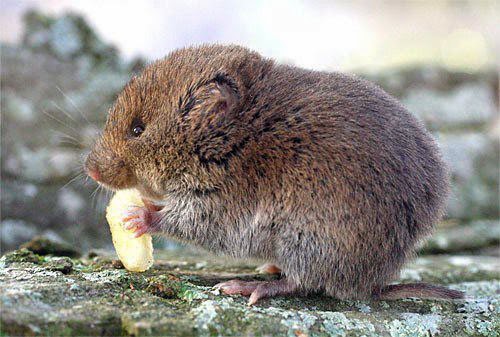Shidlovsky’s pine vole: Red Data Book of Armenia

True hamsters, voles, New World rats and relatives – Cricetidae
Status. An endemic species. Listed in the IUCN Red List of Threatened Species (ver. 3.1) as Least Concern. According to IUCN criteria categorized as Endangered EN B1ab(ii,iii,v).
Distribution. Central Georgia.
Distribution in Armenia. Western and northern parts of the Aragatsotn Province, central and southern parts of the Shirak Province and western and central parts of the Pambak Ridge at 1400–1700 m above sea level.
Habitats. Arid grasslands and meadows, virgin lands, swaths, crop fields and gardens located at suitable elevations.
Biological traits. This nominative species is slightly bigger than from Georgia. Visually very similar to the Günther’s vole living in Asia Minor. Lives in colonies. Burrows are simpler than in common and social voles. Feeds mainly on herbs and, on fields, also on cereals, technical and food crops. The reproductive cycle lasts, depends on spring weather, from late February to early April. The adult female can produce up to 4 litters per annum, on average, 7–8 offspring/litter. Juvenile females of the first generation can mate in the same season and produce up to 2 litters which are smaller than usual.
Population size and its trends. An endemic species of decreasing population. Since the late 1980s and especially early 1990s, the population has significantly reduced. Afterwards, only in 2003 the vole abundance has somewhere reached the long–term average population size. Some populations considered in the 1970s as stable (e.g., on the Mastarin Plateau) have virtually vanished.
Major threats. Human activities and climate change aggravated by strong rainfalls in early spring and subsequent droughts in summer affect the food base of pine voles.
Conservation measures. Not protected. It is essential to preserve the virgin lands.
Suggestions
 The Ministry of Environment sent a letter international partners to draw their attention to the real danger of environmental disasters as a result of Azerbaijan's large-scale aggression towards the territory of Armenia
The Ministry of Environment sent a letter international partners to draw their attention to the real danger of environmental disasters as a result of Azerbaijan's large-scale aggression towards the territory of Armenia
 Vicia pisiformis: Red Data Book of Armenia
Vicia pisiformis: Red Data Book of Armenia
 Vavilovia formosa: Red Data Book of Armenia
Vavilovia formosa: Red Data Book of Armenia
 Trigonella capitata: Red Data Book of Armenia
Trigonella capitata: Red Data Book of Armenia
 Trigonella astroides: Red Data Book of Armenia
Trigonella astroides: Red Data Book of Armenia












